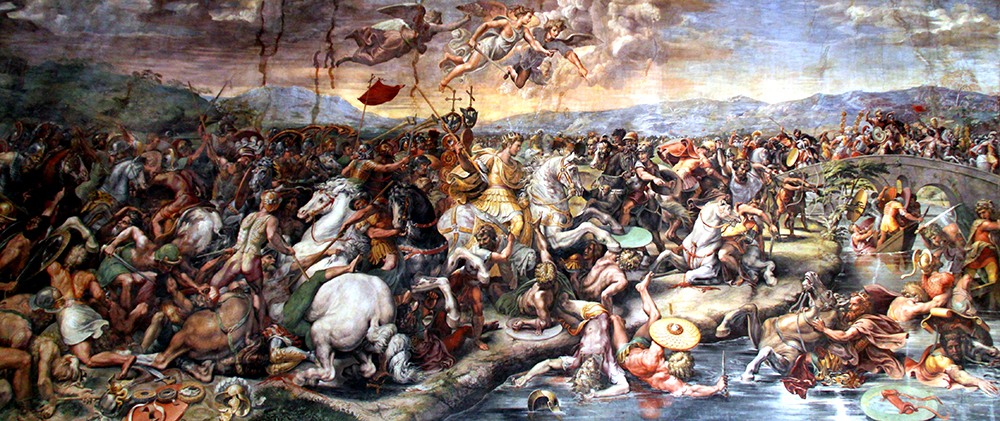
In this installment of Symbols and Symbolism, we look at the meaning behind the iconic slogan of the York Right Knight Templars – In Hoc Signo Vinces (pronounced – in hohk sig-noh wing-kase). Translated from Latin to read “By this sign thou shalt conquer,” the motto, and its corresponding association with the passion cross are, perhaps, a misrepresentation of its original and true intention and an adoption by later Christian military orders in their conquest over the pagan world.
Despite its militaristic association, the motto and the symbols it represents have perhaps a far older symbolic meaning into the mysteries of Egypt and beyond.
From Albert Mackey’s Encyclopedia of Freemasonry:
On the Grand Standard of a Commandery of Knights Templar these words are inscribed over “a blood-red Passion Cross,” and they constitute in part the motto of the American branch of the Order. Their meaning, “By this sign thou shalt conquer,” is a substantial, but not literal, translation of the original Greek. For the origin of the motto, IN HOC SIGNO VINCES (pronounced “In hoke seeg-noh ween-case” from the Greek) we must go back to a well-known legend of the Church, which has, however, found more doubters than believers among the learned. Eusebius, who wrote a life of Constantine says that while the emperor was in Gaul, in the year 312, preparing for war with his rival, Maxentius, about the middle hours of the day, as the sun began to verge toward its setting, he saw in the heavens with his own eyes, the sun surmounted with the trophy of the cross, which was composed of light, and a legend annexed, which said “by this conquer.” This account Eusebius affirms to be in the words of Constantine.

Lactantius, who places the occurrence at a later date and on the eve of a battle with Maxentius, in which the latter was defeated, relates it not as an actual occurrence, but as a dream or vision; and this is now the generally received opinion of those who do not deem the whole legend a fabrication. On the next day, Constantine had an image of this cross made into a banner, called the labarum, which he ever afterward used as the imperial standard. Eusebius describes it very fully. It was not a Passion Cross, such as is now used on the modern Templar standard, but the monogram of Christ. The shaft was a very long spear.
On the toll was a crown composed of Gold and precious stones, and containing the sacred symbol, namely, the Greek letter “rho” or P. intersected by the “chi” or X, which two letters are the first and second of the name “XRISTOS”, or Christ. If then, the Templars retain the motto on their banner, they should, for the sake of historical accuracy, discard the Passion Cross, and replace it with the Constantinian Chronogram, or Cross of the Labarum. But the truth is that the ancient Templars used neither the Passion Cross, nor that of Constantine, nor was the motto “In Hoc Signo Vinces” on their standard. Their only banner was the black and white Beauseant, and at the bottom of it was inscribed their motto, also in Latin, “Non nobis Domine, non-nobis, sed nomini to da gloriam, meaning “Not unto us, O Lord, not unto us, but unto Thee give the glory.” This was the song or shout of victory sung by the Templars when triumphant in battle.

Manly P. Hall, in his Secret Teachings of All Ages, finds parallels with In Hoc Sig Vinces in an examination of the Tau cross and the Crux Ansata, saying:
There are three distinct forms of the cross. The first is called the TAU (more correctly the TAV). It closely resembles the modern letter T, consisting of a horizontal bar resting on a vertical column, the two arms being of equal length. An oak tree cut off some feet above the ground and its upper part laid across the lower in this form was the symbol of the Druid god Hu. It is suspected that this symbol originated among the Egyptians from the spread of the horns of a bull or ram (Taurus or Aries) and the vertical line of its face. This is sometimes designated as the hammer cross, because if held by its vertical base it is not unlike a mallet or gavel. In one of the Qabbalistic Masonic legends, CHiram Abiff is given a hammer in the form of a TAU by his ancestor, Tubal-cain. The TAU cross is preserved to modern Masonry under the symbol of the T square. This appears to be the oldest form of the cross extant.
The TAU cross was inscribed on the forehead of every person admitted into the Mysteries of Mithras. When a king was initiated into the Egyptian Mysteries, the TAU was placed against his lips. It was tattooed upon the bodies of the candidates in some of the American Indian Mysteries. To the Qabbalist, the TAU stood for heaven and the Pythagorean tetracts. The Caduceus of Hermes was an outgrowth of the TAU cross.

The second type was that of a T, or TAU, cross surmounted by a circle, often foreshortened to the form of an upright oval. This was called by the ancients the Crux Ansata, or the cross of life (as illustrated as the ankh). It was the key to the Mysteries of antiquity and it probably gave rise to the more modern story of St. Peter’s golden key to heaven. In the Mysteries of Egypt, the candidate passed through all forms of actual and imaginary dangers, holding above his head the Crux Ansata, before which the powers of darkness fell back abashed. The student is reminded of the words In hoc signo vinces. The TAU form of the cross is not unlike the seal of Venus, as Richard Payne Knight has noted. He states: “The cross in this form is sometimes observable on coins, and several of them were found in a temple of Serapis [the Serapeum], demolished at the general destruction of those edifices by the Emperor Theodosius, and were said by the Christian antiquaries of that time to signify the future life.”
Augustus Le Plongeon, in his Sacred Mysteries Among the Mayas and Quiches, notes that the Crux Ansata, which he calls The Key to the Nile and the Symbol of Symbols, either in its complete form or as a simple TAU, was to be seen adorning the breasts of statues and bas-reliefs at Palenque, Copan, and throughout Central America. He notes that it was always associated with water; that among the Babylonians it was the emblem of the water gods; among the Scandinavians, of heaven and immortality; and among the Mayas, of rejuvenation and freedom from physical suffering.The third form of the cross is the familiar Roman or Greek type, which is closely associated with the crucifixion of Jesus Christ, although it is improbable that the cross used resembled its more familiar modern form. There are unlimited sub-varieties of crosses, differing in the relative proportions of their vertical and horizontal sections.
Read: Christianization of Freemasonry

The third form of the cross is the familiar Roman or Greek type, which is closely associated with the crucifixion of Jesus Christ, although it is improbable that the cross used resembled its more familiar modern form. There are unlimited sub-varieties of crosses, differing in the relative proportions of their vertical and horizontal sections. Among the secret orders of different generations, we find compounded crosses, such as the triple TAU in the Royal Arch of Freemasonry and the double and triple crosses of both Masonic and Roman Catholic symbolism.
To the Christian, the cross has a twofold significance.
First, it is the symbol of the death of his Redeemer, through whose martyrdom he feels that he partakes of the glory of God; secondly, it is the symbol of humility, patience, and the burden of life. It is interesting that the cross should be both a symbol of life and a symbol of death. Many nations deeply considered the astronomical aspect of religion, and it is probable that the Persians, Greeks, and Hindus looked upon the cross as a symbol of the equinoxes and the solstices, in the belief that at certain seasons of the year the sun was symbolically crucified upon these imaginary celestial angles.


God Bless Our Freemasonry.:
Four additional kinds of cross: (1) equal arms (Templar); (2) 2 bars (Cross of Loraine); (3) 3 bars (Russian Orthodox); (4) 3-D hyper cross (Salvidor Dali’s “Corpus Hypercubus”). There are variants of each — splayed ends or not, and one or more bars horizontal or tilted. All originally relate to the alchemical symbol for a change between a volatile and fixed state, usually in a crucible (same root word as crucify). This symbol was used worldwide long before being adopted by Christianity (see THE WORLD’S SIXTEEN CRUCIFIED SAVIORS by Kersey Graves).
The words are Latin, not Greek.